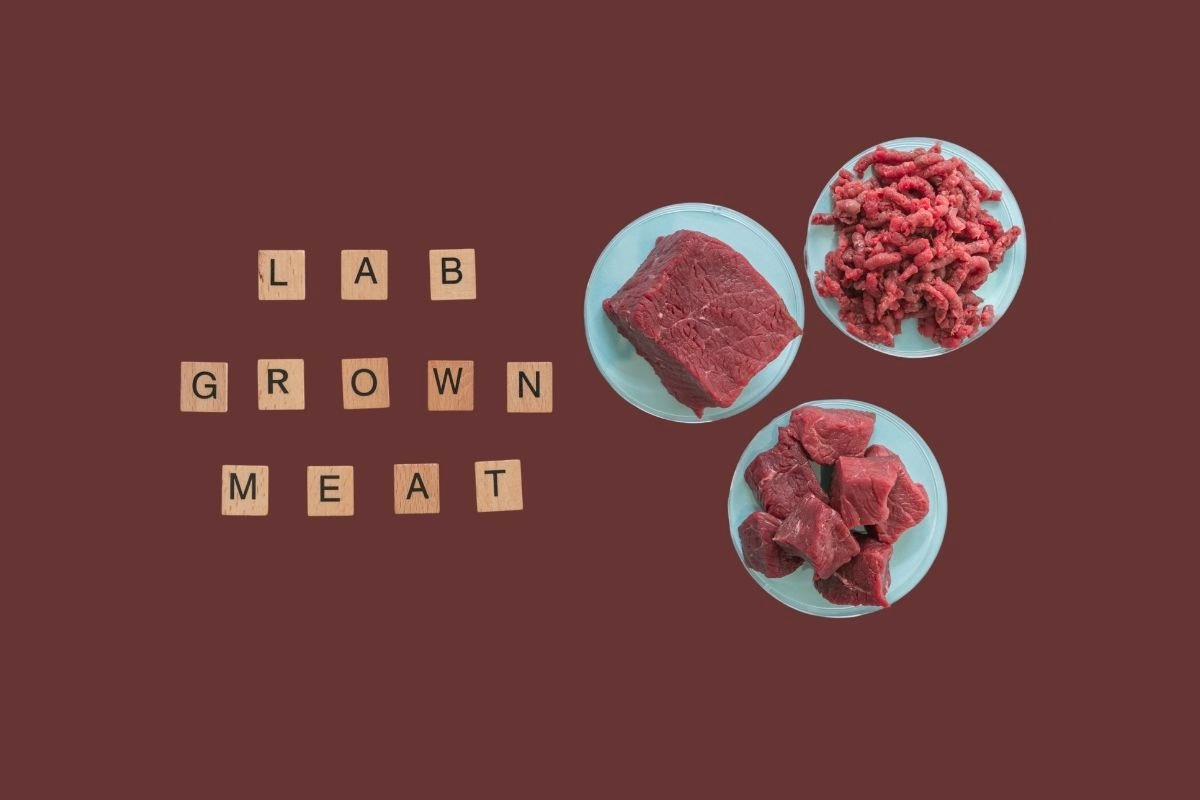
This excerpt from “Lab-Grown Meat: Potential Health Benefits of Consumption” by Imrul Qayes explores the production and potential health implications of lab-grown meat. The text details how this cultured meat is created by growing animal cells in a controlled lab setting, contrasting this process with traditional meat production. A central theme emphasizes the potential health benefits of lab-grown meat, including reduced risk of foodborne illnesses and the ability to customize its nutritional profile. However, the article also acknowledges the need for further research to fully understand potential long-term health effects and address consumer concerns. Ultimately, the excerpt aims to inform readers about the science, benefits, and future of this innovative and potentially transformative food source.
Why Should Consumers Consider Lab-Grown Meat for Health?
A world where your favorite steak or burger is not only delicious but also free from the ethical and environmental concerns of traditional meat production. Welcome to the future of food—lab-grown meat. This revolutionary innovation, also known as cultured or cell-based meat, is created by cultivating animal cells in a controlled lab environment, bypassing the need for raising and slaughtering livestock. But it’s not just about being kinder to animals and the planet; It is also holds incredible promise for improving human health.
Unlike conventional meat, which can carry risks like foodborne illnesses, antibiotic residues, and high levels of saturated fats, lab-grown meat offers a cleaner, safer, and more customizable alternative. Imagine meat that’s free from harmful bacteria, tailored to provide optimal nutrition, and even designed to support specific dietary needs. Sounds like science fiction? It’s not—it’s the reality of cell-based meat, and it’s already making waves in the food industry.
But how exactly does cell-based meat work, and what makes it a healthier choice?
From reducing exposure to pathogens to offering the potential for enhanced nutritional profiles, the health benefits of cell-based meat are as exciting as they are transformative. In this article, we’ll dive deep into the science behind this innovation, explore its potential health advantages, and uncover why it might just be the key to a healthier, more sustainable future.
Ready to explore how lab-grown meat could change the way we eat—and live?
Let’s take a closer look at “The Future Of Human Healthcare: Innovations And Advancements”
What is lab-grown Meat?
Imagine enjoying your favorite burger or steak without harming animals, damaging the environment, or worrying about health risks. This isn’t a far-off idea—it’s already happening with lab-grown meat, one of the most exciting new developments in the human food industry.
Lab-grown meat, also called cultured or cell-based meat, is made by growing animal cells in a lab. Instead of raising and killing animals, scientists take a small sample of cells—usually from a cow, chicken, or fish—and feed them a nutrient-rich mixture in a clean lab setting. These cells grow and multiply, eventually forming muscle tissue, which becomes meat ready to cook and eat.
So, what makes lab-grown meat so special? It’s not just about avoiding animal cruelty or helping the environment. It’s also about creating safer and healthier food. Since the meat is grown in a controlled, sterile environment, it avoids many problems with traditional meat, like harmful bacteria, foodborne illnesses, or antibiotic residues. On top of that, lab-grown meat can be customized to be healthier—like making it lower in unhealthy fats or adding more nutrients.
In this section, we’ll explain how cell-based meat is made, how it could improve health, and why it might change the way we think about food in the future. Curious to learn more about the science, the possibilities, and the exciting future of lab-grown meat? Let’s dive in!
Definition and Importance of Lab-Grown Meat
Lab-grown meat, also called cultured or cell-based meat, is made by growing animal cells in a lab instead of raising and killing animals. Scientists start by taking a small sample of cells from an animal, like a cow, chicken, or fish. These cells are then fed with a nutrient-rich mixture in a clean and controlled lab environment. Over time, the cells grow and multiply, eventually forming muscle tissue, which is harvested and used as meat.
This new way of producing meat is important because it can help solve some of the biggest problems caused by traditional meat production. For example, lab-grown meat uses less land, water, and animal feed, which helps reduce pollution and greenhouse gas emissions. It also avoids the need to kill animals, making it a cruelty-free option.
But what’s even more exciting is how lab-grown meat could improve human health. Because it’s grown in a sterile environment, it avoids problems like harmful bacteria, food poisoning, or antibiotics that are often found in regular meat. On top of that, it can be designed to be healthier—like making it lower in unhealthy fats or adding extra vitamins and nutrients.
Lab-grown meat is more than just a sustainable option—it could also be a safer and healthier choice for people. When you combine this with the ideas in the previous section, it’s clear that lab-grown meat could completely change how we think about and consume food in the future.
How Lab-Grown Meat is Produced
The way lab-grown meat is made is both simple and fascinating. It’s a mix of science and technology that creates real meat without needing to raise or harm animals. Here’s how it works:
- Taking Animal Cells
Scientists start by taking a tiny sample of cells from an animal, usually through a harmless procedure. These are special cells, like stem cells or muscle cells, that can grow and multiply over time. - Giving the Cells Food
The cells are put into a special container called a bioreactor. Inside, they’re fed a nutrient-rich liquid full of proteins, vitamins, and sugars. This liquid acts like the food animals would get in their bodies, helping the cells grow. - Growing the Meat
Over the next few weeks, the cells grow and multiply, forming muscle tissue. This muscle tissue is what becomes the meat. Everything happens in a controlled, clean environment to make sure the process is safe and effective. - Harvesting the Meat
Once the muscle tissue is fully grown, it is carefully collected. After this, it’s processed and shaped into different types of meat, like burgers, nuggets, or even steaks, ready to be cooked and eaten.
Why This Process is Better
cultured meat is made in a very clean and safe place, so it doesn’t have the same risks as traditional meat. There’s no chance of harmful bacteria like E. coli or Salmonella. This makes it safer to eat.
Also, lab-grown meat doesn’t need antibiotics or hormones, which are often used in farming. This means it’s healthier for people and doesn’t add to the problem of antibiotic resistance.
Another great thing is that lab-grown meat can be made to be healthier. For example, it can have less fat or be enriched with nutrients to make it even better for you.
This new way of making meat is not only safer and healthier but also much kinder to animals and better for the environment. It’s a big step forward in how we produce food!
Health Benefits of Lab-Grown Meat
When it comes to food, health is always a top priority. Lab-grown meat isn’t just a sustainable and ethical alternative to traditional meat—it’s also packed with potential health benefits that could revolutionize the way we think about protein. From reducing the risk of diseases to offering customizable nutrition, cultured meat is setting a new standard for what meat can be. Let’s explore how this innovative food source could improve your health and well-being.
Reduced Risk of Zoonotic Diseases
One of the most significant health benefits of lab-grown meat is its ability to reduce the risk of zoonotic diseases—illnesses that can be transmitted from animals to humans. Traditional meat production is often associated with outbreaks of diseases like salmonella, E. coli, and even avian flu, which can pose serious health risks to consumers.
Lab-grown meat, on the other hand, is produced in a sterile, controlled environment. This means there’s no exposure to the bacteria, viruses, or parasites commonly found in livestock farming. By eliminating these risks, lab-grown meat offers a safer, cleaner alternative to conventional meat.
Additionally, lab-grown meat is produced without the use of antibiotics, which are often overused in traditional livestock farming to prevent disease and promote growth. This overuse has led to the rise of antibiotic-resistant bacteria, a growing public health concern. With lab-grown meat, you can enjoy your favorite protein without worrying about antibiotic residues or resistance.
In short, lab-grown meat isn’t just better for the planet—it’s better for your health, too.
Nutrient Fortification and Customization
What if your steak could be as nutritious as a bowl of kale? With lab-grown meat, that’s not just a possibility—it’s a reality. One of the most exciting aspects of The meat of lab-grown is its potential for nutrient fortification and customization.
In a lab setting, scientists can engineer The meat of lab-grown to include higher levels of essential nutrients like omega-3 fatty acids, vitamins, and minerals. For example, imagine a burger that’s not only delicious but also packed with heart-healthy omega-3s, or chicken nuggets enriched with iron and vitamin B12. This level of customization could help address common nutritional deficiencies and support overall health.
The meat of lab-grown also has the potential to be lower in unhealthy fats. Traditional meat often contains high levels of saturated fats, which can contribute to heart disease and other health issues. By tweaking the cell culture process, scientists can produce lab-grown meat with a healthier fat profile, making it a smarter choice for your diet.
The possibilities don’t stop there. Lab-grown meat could even be tailored to meet specific dietary needs, such as low-sodium options for people with high blood pressure or high-protein versions for athletes. It’s like having a personalized nutrition plan built right into your food.
In essence, lab-grown meat isn’t just a sustainable alternative—it’s a healthier one, offering the potential for improved nutrition and better health outcomes.
The Future of Lab-Grown Meat
The future of food is here, and it’s called lab-grown meat. This innovative technology isn’t just a passing trend—it’s a game-changer that’s set to transform the way we produce and consume meat. From cutting-edge production techniques to its role in building sustainable food systems, cultured is paving the way for a healthier, more ethical, and environmentally friendly future. Let’s take a closer look at what lies ahead for this groundbreaking innovation.
Innovations in Production Technology
One of the most exciting aspects of lab-grown meat is the rapid pace of technological advancements. When the concept of The meat of lab-grown first emerged, it was expensive and time-consuming to produce. But thanks to innovations in production technology, the process is becoming more efficient, cost-effective, and scalable.
For example, scientists are now using bioreactors—large, controlled environments where cells can grow—to produce meat on a larger scale. These bioreactors are becoming more advanced, allowing for faster cell growth and higher yields. Additionally, researchers are exploring ways to reduce the cost of the nutrient-rich medium needed to grow the cells, making meat more affordable for consumers.
Another breakthrough is the development of 3D bioprinting, which allows scientists to create complex meat structures, like steaks or chicken breasts, layer by layer. This technology could bring the meat of lab-grown closer to the texture and taste of traditional meat, making it even more appealing to consumers.
As these innovations continue to evolve, The meat of lab-grown is becoming more accessible and practical, paving the way for broader adoption and integration into our food systems.
Role in Sustainable Food Systems
The environmental impact of traditional meat production is undeniable. From deforestation and greenhouse gas emissions to excessive water usage, the way we produce meat today is taking a toll on the planet. This is where lab-grown meat comes in as a sustainable alternative.
The meat of lab-grown has the potential to significantly reduce the environmental footprint of meat production. For starters, it requires far less land and water compared to traditional livestock farming. It also produces fewer greenhouse gas emissions, helping to combat climate change.
But the benefits don’t stop there. The meat of lab-grown can be produced without the need for antibiotics or hormones, reducing the risk of antibiotic resistance and pollution from agricultural runoff. It also eliminates the ethical concerns associated with animal slaughter, offering a cruelty-free option for meat lovers.
By integrating the meat of lab-grown into our food systems, we can create a more sustainable and resilient future. It’s not just about feeding the growing global population—it’s about doing so in a way that protects the planet and promotes health and well-being.
In short, The meat of lab-grown isn’t just a food innovation—it’s a sustainability solution that could change the way we think about meat production and consumption.

Frequently Asked Questions The meat of Lab-grown
1. What is lab-grown meat?
Lab-grown meat, also called cultured or cell-based meat, is real meat made in a lab instead of being taken from slaughtered animals. Scientists take a small sample of cells from an animal, such as a cow, chicken, or fish, and place those cells in a nutrient-rich solution. These cells grow and multiply in a controlled environment until they form muscle tissue, which is the main component of meat. The result is real meat that is more sustainable and ethical than traditional farming methods.
2. What are the health benefits of lab-grown meat?
Lab-grown meat comes with many health benefits. Because it’s grown in a sterile environment, it eliminates the risk of foodborne illnesses like Salmonella and E. coli that are common in traditional meat. It also doesn’t require antibiotics, reducing the risks linked to antibiotic resistance. Additionally, lab-grown meat can be customized to include extra nutrients like omega-3 fatty acids, vitamins, and minerals, making it a potentially healthier choice compared to regular meat.
3. Are there any health risks associated with lab-grown meat?
Although lab-grown meat is made in a very clean and safe way, there are still some questions about its long-term health effects. For example, there is a possibility that certain people might have allergic reactions to the nutrients or growth factors used in the production process. Scientists are also studying how lab-grown meat might affect human health over time. While it appears to be safe so far, more research is needed to fully understand its risks.
4. How does lab-grown meat compare to traditional meat nutritionally?
Nutritionally, lab-grown meat is very similar to traditional meat because it is real meat made from animal cells. However, lab-grown meat can be designed to be healthier. For instance, producers can adjust the fat content to make it lower in saturated fats or enrich it with healthy nutrients like omega-3 fatty acids, iron, or vitamins. This flexibility makes it possible to create meat that is not only delicious but also better for your health.
5. Is lab-grown meat safe to eat?
Yes, lab-grown meat is considered safe to eat because it is made in sterile, controlled environments where contamination is not an issue. It avoids common risks like harmful bacteria and antibiotic residues often found in traditional meat. However, since lab-grown meat is still relatively new, scientists and regulators are closely studying its safety, and more long-term research will help confirm its effects on human health.
6. What are the challenges of lab-grown meat adoption?
There are several challenges in bringing lab-grown meat to the masses. The first challenge is the cost of production, which is still high but improving as technology advances. Second, there are strict regulations that companies need to meet before lab-grown meat can be sold widely. Lastly, some people might feel hesitant to try it because it’s made in a lab and might seem unfamiliar or “unnatural.” Educating people about its benefits will be key to gaining their trust and acceptance.
7. What is the future of lab-grown meat?
The future of lab-grown meat looks promising. As technology improves, production costs are expected to go down, making it more affordable and available. Governments and companies are working together to bring lab-grown meat into mainstream markets. It’s likely to play a big role in creating a more sustainable food system by reducing the environmental impact of meat production. In the coming years, we may see lab-grown meat becoming a common option in supermarkets and restaurants around the world.
8. How is lab-grown meat made?
The process of making lab-grown meat starts with taking a small sample of cells from an animal. These cells are placed in a bioreactor, a controlled environment where they are fed a nutrient-rich solution containing proteins, sugars, and vitamins. Over several weeks, the cells multiply and form muscle tissue, which is then harvested and shaped into meat products like burgers or steaks. The entire process is carefully monitored to ensure the meat is clean, safe, and high-quality.
9. Can lab-grown meat help reduce environmental impact?
Yes, lab-grown meat has a much smaller environmental footprint compared to traditional meat production. It uses less land, water, and energy, and it produces fewer greenhouse gas emissions. This makes it a more sustainable choice that can help combat climate change. By reducing the need for livestock farming, lab-grown meat also minimizes deforestation and pollution, making it a better option for the planet.
10. Will lab-grown meat taste the same as traditional meat?
Yes, lab-grown meat is designed to look, feel, and taste just like traditional meat because it’s made from the same animal cells. Scientists are constantly improving the texture, flavor, and appearance of lab-grown meat to match or even surpass conventional meat. Many people who have tasted it say it’s almost impossible to tell the difference.
11. Is lab-grown meat vegan or vegetarian?
No, lab-grown meat is not vegan or vegetarian because it is made from animal cells. However, it is considered cruelty-free since it doesn’t involve raising or slaughtering animals. Some vegetarians and vegans who avoid meat for ethical reasons might consider eating lab-grown meat, but it ultimately depends on personal beliefs.
12. How soon will lab-grown meat be available to consumers?
Lab-grown meat is already available in some places, like Singapore and certain U.S. restaurants, but it’s not yet widely accessible. Factors like regulatory approval, production costs, and public acceptance will determine how quickly it becomes more common. Experts predict that lab-grown meat could be widely available in supermarkets and restaurants within the next 5 to 10 years.
13. What are the ethical benefits of lab-grown meat?
Lab-grown meat offers significant ethical benefits. It eliminates the need to slaughter animals, which helps reduce animal suffering. It also addresses concerns about the inhumane conditions often found in factory farms. By providing a cruelty-free alternative, lab-grown meat aligns with the growing demand for more ethical and sustainable food options.
Conclusion: A New Era of Meat is Here
The future of food is no longer a distant dream—it’s happening right now, and lab-grown meat is at the forefront of this transformation. From its potential to revolutionize health and nutrition to its role in building sustainable food systems, The meat of lab-grown is proving to be more than just an alternative to traditional meat—it’s a solution to some of the biggest challenges facing our planet and our plates.
With advancements in production technology making it more cost-effective and scalable,The meat of lab-grown is becoming a viable option for consumers worldwide. Its ability to reduce the risk of zoonotic diseases, offer customizable nutrition, and minimize environmental impact makes it a game-changer in the food industry.
As we look ahead, the possibilities for lab-grown meat are endless. From reducing our carbon footprint to providing safer, healthier, and more ethical food choices, this innovation is paving the way for a brighter, more sustainable future.
The question isn’t whether lab-grown meat will become a part of our lives—it’s how soon we’ll embrace it.
Are you ready to be part of this food revolution?
The future of meat is here, and it’s lab-grown.





